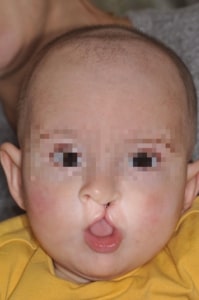Cheilorhinoplasty Tunisia
What is Cheilorhinoplasty?
 Non-syndromic complete unilateral cleft lip and palate can be treated with a surgical procedure called cheilorhinoplasty. In general, this procedure is performed with the aim of improving the aesthetic appearance while avoiding complications such as retromaxillia, tongue hypertrophy and difficulty to chew. Cheilorhinoplasty can be performed at different ages, ranging from 1 month to 12 months, and it is often combined with other surgical procedures, such as primary and secondary velopalatoplasty.
Non-syndromic complete unilateral cleft lip and palate can be treated with a surgical procedure called cheilorhinoplasty. In general, this procedure is performed with the aim of improving the aesthetic appearance while avoiding complications such as retromaxillia, tongue hypertrophy and difficulty to chew. Cheilorhinoplasty can be performed at different ages, ranging from 1 month to 12 months, and it is often combined with other surgical procedures, such as primary and secondary velopalatoplasty.
What is the difference between traditional rhinoplasty and cheilorhinoplasty?
L'objectif de la rhinoplastie traditionnelle est d'améliorer l'apparence du nez en réduisant sa taille, en corrigeant une déformation ou en modifiant la forme de la pointe du nez. Cependant, les fentes labio-palatines unilatérales complètes non syndromiques peuvent être traitées par une intervention chirurgicale appelée chéilorhinoplastie.
How is recovery after cheilorhinoplasty?
Healing requires regular monitoring to assess the progress of healing and the absence of deformation, as well as close monitoring to detect any signs of complications.
To adapt the therapeutic treatment modalities, it is essential that patients benefit from regular and prolonged follow-up, and that the coordination of each specialty is ensured in order to ensure a complete evaluation of long-term aesthetic and functional results. term.
What are the advantages ?
Improvement of aesthetic appearance: Cheilorhinoplasty improves the aesthetic appearance of patients by reducing the size of the cleft lip and palate, by correcting a deformity or modifying the shape of the tip of the nose.
Prevention of potential complications: Complications such as retromaxillia, hypertrophy of the Tongue and difficulty in chewing are avoided during the procedure.
Regular and prolonged follow-up: Management of cleft lip-alveolar-velo- palates is a multidisciplinary process that may involve several medical specialists and surgeons, and it must include a rigorous etiological workup to identify any syndromic associations or malformations that could compromise surgery.
Association with other surgical procedures: Cheilorhinoplasty is often associated with other surgical procedures, such as primary velopalatoplasty and secondary velopalatoplasty, which may impact the time it takes to recover from surgery.
What are the possible complications of the surgery?
Retromaxillia, which is a recession of the upper jaw, and velar insufficiency, which is characterized by a soft palate that does not properly perform all of its functions, are possible complications of cheilorhinoplasty. Although these are generally rare, bleeding, postsurgical infections, and suture dehiscence are also potential complications. It is important to note that these complications can be treated with a precise procedure by a specialized surgeon.
How long does the cheilorhinoplasty procedure take?
The duration of the cheilorhinoplasty procedure varies depending on the technique used and the complexity of each case. Primary cheilorhinoplasty can last from 40 minutes to 2 hours.
What are the long-term results?
Although the aesthetic and functional results of cheilorhinoplasty can only be evaluated after several years, the long-term results are generally satisfactory. Although a number of modifications and revisions may be necessary, Millard's methods and its derivatives are generally satisfactory.
Are there any special recommendations before surgery?
Before cheilorhinoplasty, there are recommendations which may vary depending on each clinical case. It is crucial that patients undergo a complete evaluation before surgery to determine their overall health and ensure they are fit to undergo surgery. Additionally, because certain medications may increase the risk of bleeding during the procedure, patients should tell their surgeon about all medications they are taking, including over-the-counter medications and supplements. Before the procedure, patients should avoid smoking and drinking alcohol as this can affect healing and increase the risk of postoperative complications.
Does cheilorhinoplasty correct functional problems of the nose?
Cheilorhinoplasty, a surgical procedure to correct cleft lips and palates, can help improve functional problems of the nose, such as breathing problems and eating disorders.